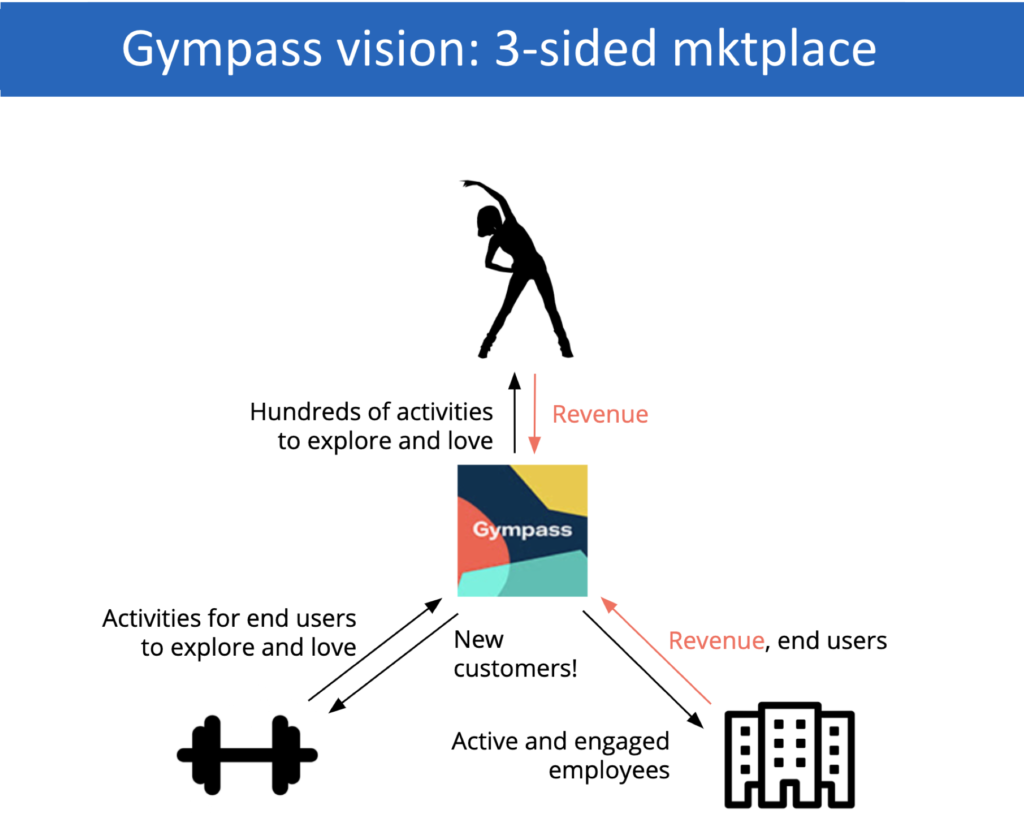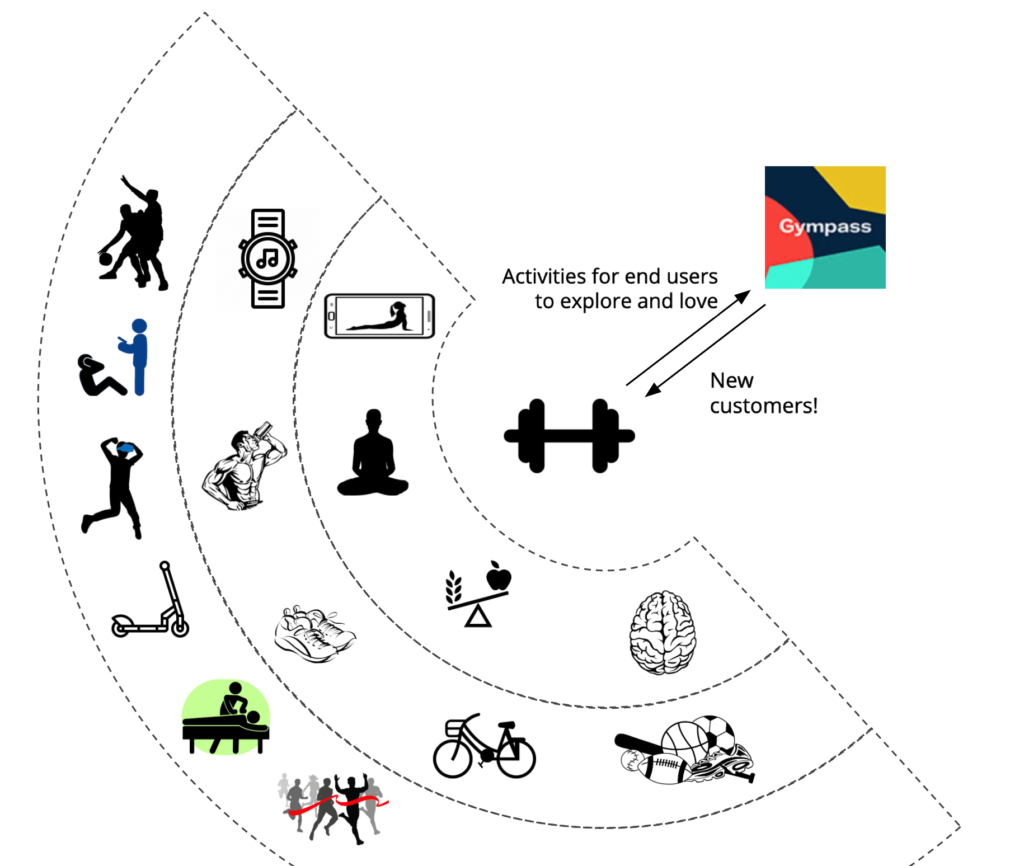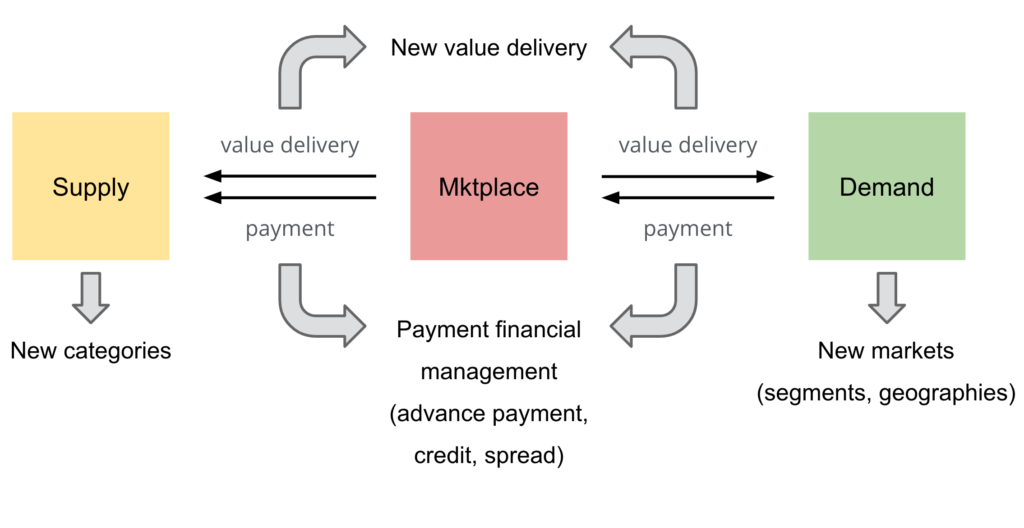New book: Digital products leadership
29 de December, 2020Vision, strategy, objectives, and team structure
2 de February, 2021This value I learned at Gympass. It was one of the company’s corporate values ​​and, in my opinion, every platform must incorporate this value in its culture. I often came across CEOs and heads of platform products who claimed that they do everything for the customer, that the entire company is customer-centric. However, when I dive deeper in this topic, I end up discovering that the client they were referring to was just one of the actors of their platform and the others were treated only as “necessary evil”.
In the description of the value on the Gympass website it is written:
Ecosystem mindset
We make decisions that create value for our Gympass ecosystem and help us achieve our mission.
The ecosystem mindset example I will describe below is the implementation of the live classes product that Gympass created during the COVID-19 crisis.
Diversifying – and digitizing – a product portfolio
During the COVID-19 pandemic, we diversified – and digitized – our product portfolio in record time. We went from an offline product, access to gyms and studios, to 4 products, 3 of them totally digital, in less than a month:
- Access to gyms and studios: Access to more than 50,000 gyms and studios in 14 countries;
- Live classes: for those who like to train in groups or want to relive the feeling of the class with colleagues at the gym;
- Personal trainers: for those who prefer a more personalized approach and like to exercise in their own time;
- Gympass Wellness: app package with over 60 apps for those looking for options to improve physical and mental well-being (from nutrition to therapy session).
Below I explain how we did it.
Product Vision
When I joined Gympass in mid-2018, one of the first things I did was to build a product vision. We had a very strong purpose: to defeat inactivity. However, to build a digital product, we need more than a purpose.

This vision guided the definition of the Gympass product development organization. As I commented in the chapter Team structure, we set up teams around each of the marketplace participants, in addition to a central team that worked in the payment flow collecting the payment from the companies and their employees, doing all the calculations, and determining the amount to be paid to each gym partner.
When I was building this product vision and discussing it with different people in the organization, it was easy to see many opportunities to expand that marketplace. There are a lot of new service categories that we could add to our marketplace:

There are 3 types of elements in a market:
- Supply: goods or services available for consumption.
- Demand: people or companies that may need goods or services offered by the supplier.
- Market: where demand meets supply and a transaction occurs.
These three elements are related as follows:
- Value delivery: the market adds value to demand and supply. The value delivered to the supply is people or companies interested in their goods or services. The value delivered to demand is a varied number of suppliers of goods and services.
- Payment: To have access to goods and services offered by suppliers, demand pays the market and the market pays for the supply. The market typically retains a fee per transaction. This fee can be fixed or a percentage of the payment.

Given the dynamics above, we can expand a market as follows:
- Diversification of demand: you can offer goods and services from your marketplace to new segments and geographic regions.
- Supply diversification: you can offer new goods and services to your demand.
- Delivery of new value: you can offer new value to your supply and demand.
- Financial payment management: as the demand payment to the supply passes through the marketplace, you can offer financial services for both demand and supply, such as advance payment and credit, and you can manage the spread.

However, we had a lot to do with our main product at that time, so we didn’t have enough energy to focus on expanding our marketplace and left the plans in the drawer.
New endeavor
In October 2019, we reached a point where our product development team was well structured and working properly to address our challenges in our core product, so we decided to focus on expanding our marketplace.
We decided to work on an idea called “Gympass end-user partnership hub”. The plan was to partner with wellness apps and provide them to our users.
This new idea had two main hypotheses that we needed to test:
- Application providers willingness to partner. Application providers, like gyms, are used to the recurring monthly revenue model. Would they accept to be paid per day of use?
- Our user base willingness to pay. Is our user base interested in paying a monthly fee to access the applications?
To test our first hypothesis, we built a deck with the value proposition that we planned to deliver to the partners and talked to some potential partners. We presented the opportunity to 8 potential partners, of whom 6 showed interest and 4 decided to join our proof of concept. NEOU, a workout app, 8fit, a workout and nutrition app, Tecnonutri, a nutrition app and ZenApp a meditation app.
Okay, our first hypothesis was validated and we needed to validate the second hypothesis, the willingness to pay. Is our user willing to pay to access these applications through Gympass?
To test our second hypothesis, we built a simple form, where we described the product and asked for name, email and company. After the user provided this information, he was directed to a Paypal subscription page, where he had to provide his credit card details to subscribe to the service. The user would receive an email with the activation link for each application. There was no real product, no logged in area, just a form to test interest and an email with links to the applications.
Initially, we call it Gympass W, the W meaning wellness. We added a beta so that everyone could understand that it was not a finished product. Later, we renamed it to Gympass Wellness to make its value proposition clearer.
Our plan was to test this proof of concept with 5 corporate clients in the USA and 5 in Brazil, which would provide us with a potential user base of 15,000 employees. Our expectation was to have around 200 subscribers. We launched internally – eat your own dog food – on March 9, 2020 and had 66 subscribers from our 1,200 employees. Then came COVID-19.
COVID-19
When a company is hit by a crisis, it needs to look at these two perspectives:
- preserve cash;
- identify and adapt to changes in customer problems and needs.
Although product managers and product development teams play an important role in the former, their primary role is in the latter.
At Gympass we have 3 different clients and all of them deeply impacted by COVID-19:
- gyms in many cities have been closed to support with physical distance measures applied to prevent the spread of COVID-19 and, consequently, are losing recurring revenue from users who were not going to the gyms;
- users, employees of our customers, can no longer go to the gyms and have to stay at home, but they also have to remain active in some way, but their first reaction was to cancel or pause their Gympass subscription, because they didn’t have access to the gyms for a while;
- corporate customers, whose employees are at home and no longer go to gyms, while HRs are concerned with how to keep these employees engaged and productive.
Gympass Wellness, the first digital product
We were able to adapt our Gympass Wellness pilot in record time to be offered to our entire user base, so that they can remain active, and also take care of their nutrition and their minds during these challenging times. With Gympass Wellness, we were able to address the problems and needs of users and our corporate customers during the crisis.
And here comes the ecosystem mentality. We must always look at all participants in our marketplace and ensure that everyone benefits from using it.
Live Classes, the second digital product
With Gympass Wellness, we were able to meet the needs of our corporate customers and their employees. But what about the gyms? When closed, they were losing revenue. Their customers no longer visited them, so regular gym users were likely to cancel their subscription, while those who used to go to gyms using Gympass did not go to the gym during the crisis, which would cause a loss of revenue for gyms as well. To help partner gyms cope with this very difficult situation, we decided and implemented 2 solutions in record time:
- We provided the academies with a white-label application so that they can offer it to all their customers, regardless if they were or weren’t employees of Gympass customers, so that the gyms could deliver value to their customers, helping them to stay active at their homes;
- We provided a platform for gyms to schedule and broadcast live classes to all Gympass users, so they can keep their instructors employed, while providing Gympass users with exclusive content. This platform is called Live Classes.
Personal Trainers, the third digital product
Live Classes provided a 1:N platform, which means that an instructor could provide physical activity guidance to N users. We soon realized that we could create another product in addition to Live Classes. Workout guidance 1:1, which could be made available in Gympass’ higher tier plans. Then we created our third digital product, Personal Trainers.
Summing up
- Ecosystem mindset means making decisions that create value for all actors on a platform.
- At Gympass, during the COVID-19 crisis, after offering Gympass Wellness for all its customers and their employees, an important part of the ecosystem was still suffering, the gyms. It was the ecosystem mindset that guided Gympass to create Live Classes product, which allowed gyms to continue operating even though they were behind closed doors.
There, with this chapter we conclude the second part of the book, on Principles. Here we saw my personal leadership principles:
- People: priority # 1, always
- Leading is like being a doctor
- Leading under pressure
- Mentoring is a two-way street
- How and when to delegate
We also saw what corporate culture is, a set of ways shared by a group of people working together on how to solve problems and react to situations. We also saw the 5 values ​​needed to create successful digital products:
- Don’t waste time looking for culprits, focus on learning
- Don’t compare work situations with war, nobody wants to kill anyone
- Profit and revenue are consequences, they should not be the main focus
- Transparency, the foundation of a high-performance team
- Diversity, the basis of the best products
Finally, we saw a set of four values ​​that are in fact the core of the entire digital product development team. These are the values ​​that make up the product culture, which is the set of behaviors of the digital product development teams that produce the best results:
In the next chapter we’ll start the third and final section of the book, about tools! \o/
Digital Product Management Books
Do you work with digital products? Do you want to know more about how to manage a digital product to increase its chances of success, solve its user’s problems and achieve the company objectives? Check out my Digital Product Management bundle with my 3 books where I share what I learned during my almost 30 years of experience in creating and managing digital products:
- Startup Guide: How startups and established companies can create profitable digital products
- Product Management: How to increase the chances of success of your digital product
- Leading Product Development: The art and science of managing product teams

